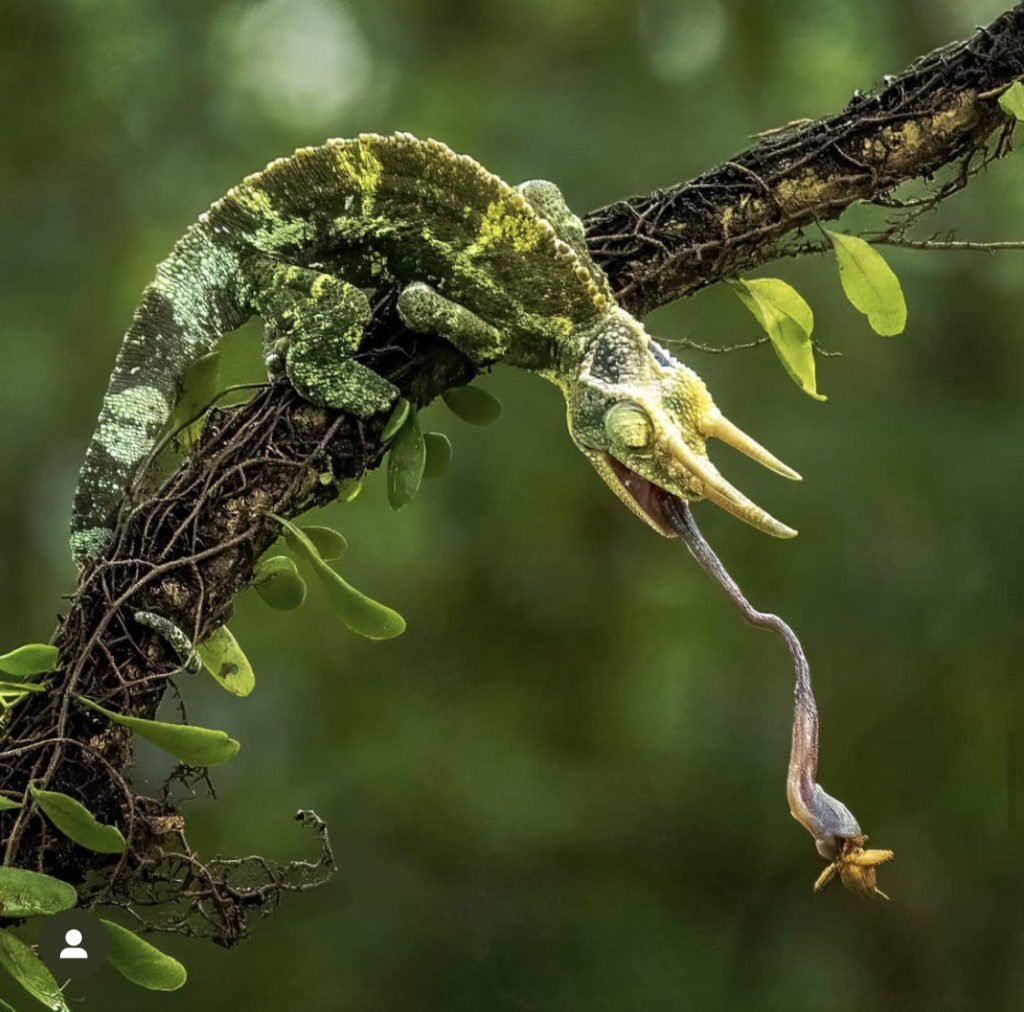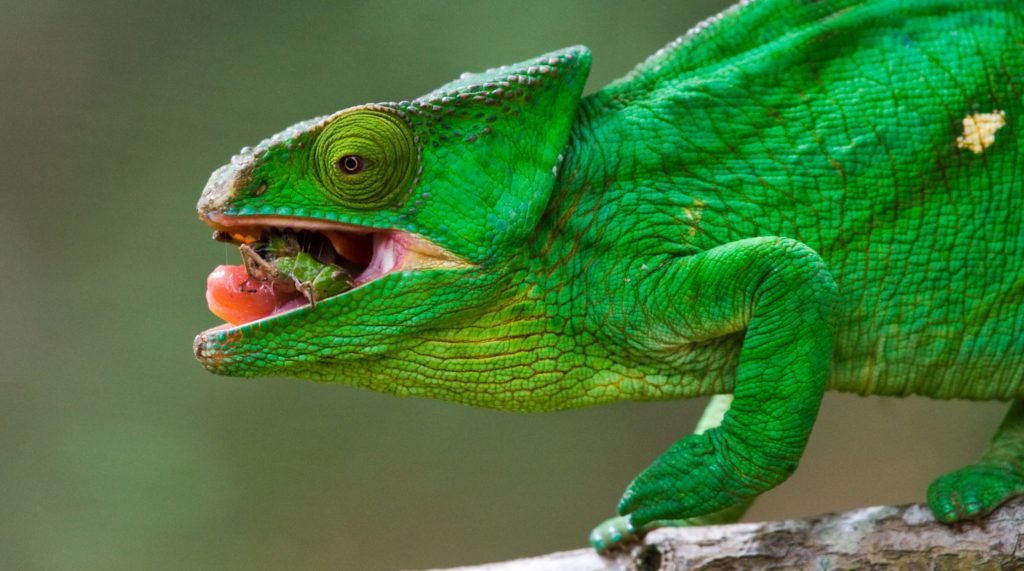Are you looking for chameleon diet information? Chameleons are unusual and exotic pets. They eat crickets, grasshoppers, leaves, flowers, and fruits in their native environment. To keep chameleons healthy, owners must understand their nutrition. This article will briefly summarize the raw diet and why chameleons need a balanced diet.
Chameleons' Natural Diet
Insects as the Primary Food Source
In the wild, chameleons depend primarily on insects for sustenance. Crickets, grasshoppers, and mantids are some of the most common insects eaten by chameleons. This insect diet provides the chameleon with many protein and energy.
Vegetation as Supplementary food
In addition to insects, chameleons consume vegetation such as leaves, flowers, and fruits as supplementary food. This variety in their diet provides them with a range of nutrients and keeps them healthy and thriving.
Hunting and Feeding Behavior
Chameleons’ distinctive hunting and eating habits make them stand out from other reptiles. They move slowly and unhurriedly in pursuit of food, capturing it with their sticky tongues. That allows them to successfully hunt and absorb food while minimizing their vulnerability to predators. Knowing what chameleons eat in the wild and how they eat it can help pet owners provide their chameleons with the best care possible.

Pet Chameleons Types of Diet
Commercial Diets
Crickets, mealworms, and waxworms are all attractive choices for commercial diets. Bugs used in commercial diets must be gut-loaded and sprinkled with vitamins and minerals.
Supplements
In addition to commercial diets, pet chameleons may also benefit from complements from vitamin and mineral supplements. Gut-loading for insects is also essential to ensure that pet chameleons receive the necessary nutrients from their food. Pet owners should work with a veterinarian or an experienced reptile specialist to determine the best supplementation and diet for their chameleons.
How Often Do Chameleons Eat?
Feeding Frequency for Adult Chameleons
Adult chameleons typically eat every day of the week. The feeding frequency will depend on the chameleon’s species, size, and individual needs.
Feeding Frequency for Young Chameleons
Young chameleons may need to eat more frequently, often every day, to support their growth and development. It is essential to consult with a veterinarian or reptile specialist to determine the appropriate feeding frequency for young chameleons.
Importance of a Consistent Feeding Schedule
Maintaining a consistent feeding schedule is vital for the health and well-being of chameleons. Inconsistent feeding can disrupt their digestive system and cause health issues. It is also essential to monitor the food offered to prevent overfeeding or underfeeding.
Where to Get Food for Pet Chameleons?
Pet Stores
Pet retailers sell chameleon food. They sell insects, vitamins, and commercial diets.
Examples:
-Petco
Online Retailers
Pet chameleons may find a wider variety of meals and exotic insects at online stores than at pet stores. The flexibility of ordering from home is another benefit of shopping online.
Example:
Importance of Sourcing from Reputable Suppliers
To avoid potential health issues, purchase food for your pet chameleon from reputable vendors. Problems with health and nutrition might result from eating low-quality food. Insects are allowed in commercial diets, but only if grown and fed by strict requirements.
Cost of Chameleons Diet?
Average Cost of Commercial Diets
The average cost of commercial diets for chameleons can vary depending on the brand and the type of diet. On average, a bag of commercial diet can cost anywhere from $10 to $20.
Cost of Feeding Live Insects
In the long term, feeding pet chameleons live insects may be cheaper than commercial meals. A jar of live crickets or mealworms costs $10–15 and lasts numerous feedings. However, feeding frequency and amount of chameleons might raise costs. Gut-loading insects with nutrients may increase charges.

Different Types of Chameleons and Their Diets
Veiled Chameleons Diet
Veiled Chameleons, also known as Yemen Chameleons, are native to the arid regions of the Arabian Peninsula. They have a predominantly insectivorous diet, with crickets and mealworms being their primary food source. They also consume smaller vegetation, including leaves, flowers, and occasionally fruits.
Jackson’s Chameleons Diet
Jackson’s Chameleons, native to East Africa, have a diet similar to Veiled Chameleons. They primarily feed on insects such as crickets, grasshoppers, and mantids and may consume small amounts of vegetation.
Panther Chameleons Diet
Panther Chameleons, native to Madagascar, have a highly varied diet, feeding on both insects and vegetation. They feed on crickets, locusts, grasshoppers, other insects, leaves, flowers, and fruits.
Adaptation to Different Habitats
Chameleons have adapted to their environments, with some species eating primarily insects and others mainly eating plants. To guarantee balanced and healthy food, pet owners must understand the nutritional needs of their unique chameleon species.
The expiration date for Chameleon Food
Shelf life of Commercial Diets
Depending on the supplier and storage conditions, chameleon pellets and canned insects last months to a year. Before purchase, verify the expiration date and store at room temperature dry place to ensure food quality.
Proper storage of Live Insects
Pet chameleons must eat crickets or mealworms. Store these insects properly to keep them fresh and nutritious for your pet. Keep live insects in a ventilated container at 65-80°F. Providing them with a healthy meal before feeding your chameleon is also necessary.
Indicators of spoiled food
When it comes to chameleons’ food, it’s essential to pay attention to expiration dates and signs of spoilage. Most commercial diets are good for several months, and keeping them in a cool, dry area is necessary to extend their shelf life. Keep live insects fresh in a well-ventilated, bedding-filled container with fresh food and water changed often.
How Many Days Can a Chameleon Go Without Eating?
Diet and feeding routine affect chameleon health. Chameleons need constant feeding to avoid malnutrition.
Importance of a Consistent Feeding Schedule
Chameleons require a balanced and varied diet to stay healthy. Irregular feeding schedules can lead to health problems and stress for the animal.
Signs of Malnutrition
If a chameleon is not eating, you may notice signs of malnutrition, such as weight loss, lethargy, and loss of appetite.
Steps to Take if a Chameleon Stops Eating
If you notice your chameleon is not eating, it’s essential to address the issue the soonest as possible. That may involve a trip to the veterinarian, a change in diet, or providing a more suitable habitat.
Allowing a chameleon to go without food for more than a few days is not recommended. Ask a vet or a more experienced chameleon keeper if you’re worried about what to feed your pet.

